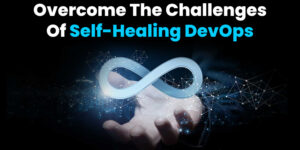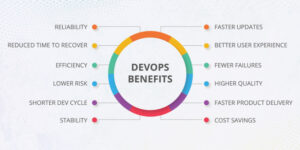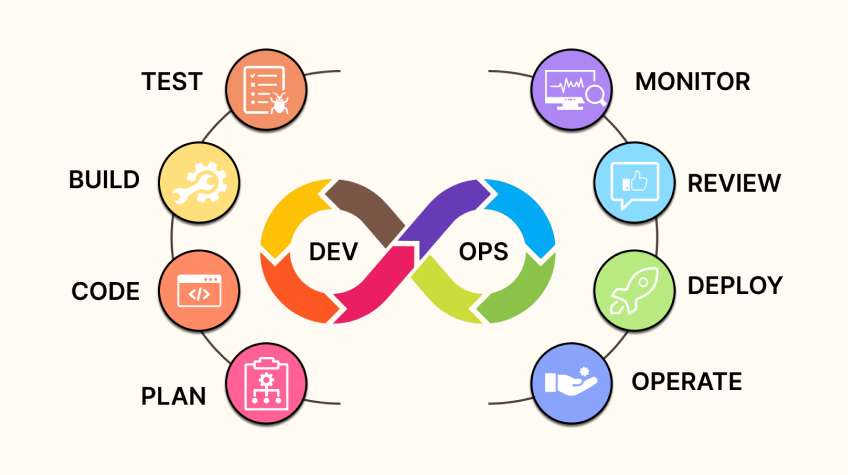
Implementing DevOps can be really beneficial for organizations. It ensures fast product delivery. Additionally, it helps minimize potential failures and delays. That’s the reason more and more organizations are now adopting for DevOps to make their products competitive and gain a competitive edge. However, it comes with its own set of challenges. Understanding how to overcome these challenges not only helps you achieve successful DevOps adaptation but also helps you make a difference. If you are a beginner and want to know how to implement it in the business for optimal outcomes, then this article is for you. Read this post to learn how to unlock the potential benefits of DevOps strategy. Let’s dive in…
Table of Content
- What is DevOps?
- Steps to Achieve Successful DevOps Adaptation: Best Practices
- STEP 1: Develop a Mindset for DevOps Strategy
- STEP 2: Determine DevOps Objectives and Goals
- STEP 3: Recognize Infrastructure Requirements
- STEP 4: Create a Comprehensive DevOps Strategy
- STEP 5: Build a DevOps Software Management Team
- STEP 6: Choose the Right DevOps Tools
- STEP 7: Integrate DevOps with CI/CD Pipelines
- STEP 8: Enhance Test Automation and Ensure Coordination of the QA Team
- STEP 9: Apply Containerization
- STEP 10: Monitor the Software’s Performance
- STEP 11: Focus on Iterative Processes
- Challenges of DevOps Adaptation in Application
- How to Overcome the Challenges of DevOps Adaptation
- The Bottom Line
- FAQs
What is DevOps?
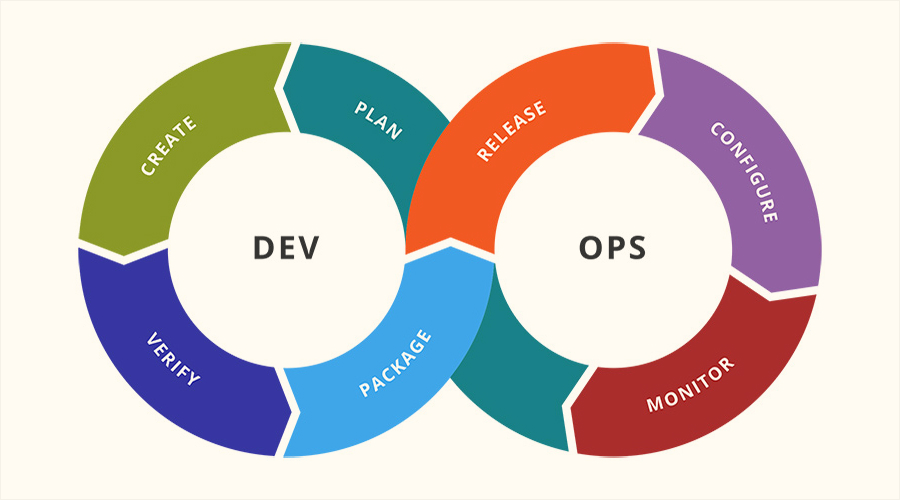
DevOps is a set of processes created to bridge the gap between software development and IT operations. This term was coined by Patrick Debois in 2009. DevOps lessens the product development life cycle and ensures the delivery of high-quality software. As a result of the DevOps implementation, the software development team does not need to struggle with endless deployment processes and bug fixes. It fosters communication between team members and automates various processes. It eliminates all kinds of obstacles during the planning, designing, and testing of the software development. All in all, it improves operational efficiency and speed of product delivery.
The key components of DevOps are continuous integration, continuous deployment, testing, monitoring, feedback, and regular improvements. It ensures faster and more reliable software launches. Organizations can efficiently participate in market changes, deliver products on time, and achieve a competitive edge.
So, how can you achieve successful DevOps adaptation? Read ahead to know…
Steps to Achieve Successful DevOps Adaptation: Best Practices
Organizations can improve team collaboration and make the software development cycle easy and manageable by adopting DevOps practices. Here is a systematic step-by-step guide to implementing DevOps practically. Read on!
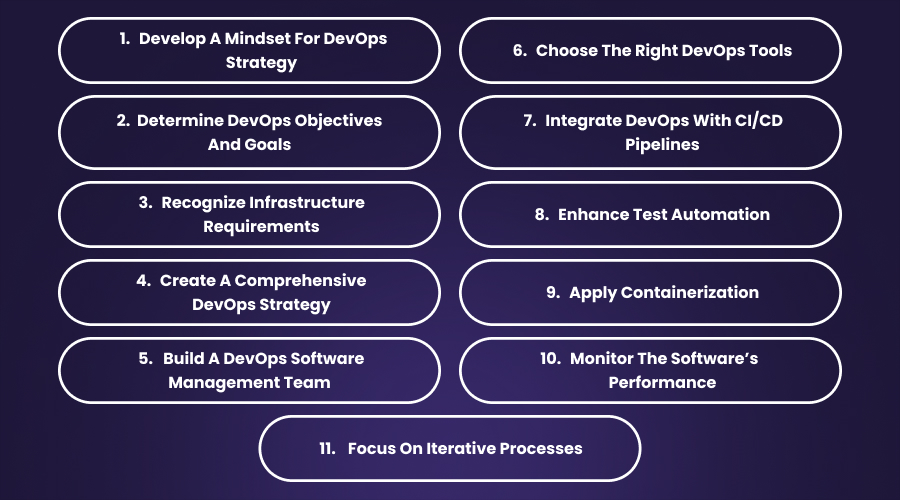
STEP 1: Develop a Mindset for DevOps Strategy
The first crucial step is developing a mindset for DevOps strategy. The team members and stakeholders should be willing to change the existing technological infrastructure. The top management should have an open discussion with the whole team and communicate the benefits of integrating DevOps into the system.
They should tell them how the new system will address the changing business needs, ensuring smooth product deliveries, fewer bugs, and improved customer satisfaction. Also, they should communicate how the automation can help in repetitive tasks, allowing the team to focus on the most significant tasks. This way, the upper management ensures everyone is involved in DevOps infrastructure to produce innovative, secure, and fast products.
Everyone involved in the team should be instructed about their roles and responsibilities. This way, there will not be any confusion or conflict when adopting DevOps practices. For a successful application, the IT director should appoint a project manager who can oversee the planning, integration, and execution.
STEP 2: Determine DevOps Objectives and Goals
It is crucial to have clear objectives and goals. This is because having clear goals and objectives make accomplishing success a breeze. Therefore, before moving forward with the DevOps adaptation, it is vital to define its objectives and goals clearly and concisely. This improves team coordination and operational efficiency, minimizing the risk of failures. So, start planning with SMART goals. Goals that are specific, measurable, achievable, relevant, and time-bound. This will help you achieve the business objectives in the long run.
STEP 3: Recognize Infrastructure Requirements
Requirements for varied IT infrastructures differ. There is no ideal roadmap that can fit different business sizes. Hence, organizations should identify their requirements while developing a strategic plan for DevOps development and execution. The requirements should be based on the business’s culture, values, and objectives. This helps organizations with a deeper understanding, which makes the adoption more lucrative to achieve future goals. Also, the software development team should thoroughly analyze the product development cycle and find the key areas for improvement. This helps them understand how to implement DevOps in the best possible manner.
In addition, it is vital to incorporate CI/CD pipelines into the workflow for a successful DevOps integration. Continuous integration helps them identify errors or bugs in the initial stages, making sure timely product launch. Continuous delivery helps deploy changes in the product to achieve optimal outcomes.
STEP 4: Create a Comprehensive DevOps Strategy
Based on the long-term business objectives and goals, a comprehensive DevOps strategy is created. It should outline effective tools, technologies, and practices to make the whole procedure smooth and seamless. The developer’s main emphasis should be an innovative approach to architecture, software development, execution, and delivery. Besides this, remember to keep your strategy flexible and scalable to the business’s evolving needs. Furthermore, DevOps should aim to improve team collaboration, enhance project members’ potential, and develop the responsibility of improving the process throughout the software development cycle.
STEP 5: Build a DevOps Software Management Team
Next, you should build a cross-functional team for a successful DevOps application. Simply put, the team should include developers, IT professionals, quality assurance engineers, testers, and security experts. The top management should encourage open communication among team members to keep them on the same page. Also, members should accept feedback and improve the highlighted bottleneck areas to multiply productivity.
STEP 6: Choose the Right DevOps Tools
Choosing the right tool is crucial for the successful DevOps adaptation. There is not a single tool that can function when you implement the DevOps software. Instead, you should search for tools and cutting-edge technologies that align with the business environment, product delivery, team, and more. The appropriate tools help organizations allocate resources and save time and money. This way, they can achieve a smooth and seamless process from the product’s development to deployment.
STEP 7: Integrate DevOps with CI/CD Pipelines
You should integrate the DevOps software development process with CI/CD pipelines. This makes the product’s life cycle safe and secure. This way, organizations can improve code quality, minimize risk, ensure faster delivery time, and explore more opportunities for creativity and innovation. Furthermore, they can identify errors and rapidly ensure bug fixes.
STEP 8: Enhance Test Automation and Ensure Coordination of the QA Tea
DevOps follows automated testing to ensure faster and smoother product delivery. So, you should implement it with the CI/CD pipelines to detect issues in the early stage before they become severe. This eliminates the need for manual testing and minimizes the risk of human errors. Also, you should coordinate with the quality assurance engineers to ensure the product’s quality will meet the intended outcomes.
STEP 9: Apply Containerization
The software developer’s priority should be container-based for making deployments more flexible, scalable, and reliable. It ensures reliability across the software development, testing, and production environments. Remember that the software development’s trustworthiness is increased by container packaging. It improves its efficiency in functioning in any context. Furthermore, containerization quickly manages the application. It allows adjustments to meet growing business needs.
STEP 10: Monitor the Software’s Performance
Next, you should monitor and evaluate the DevOps software’s performance. Many cutting-edge metrics tools can help identify irregular patterns and bottlenecks. Constant monitoring allows the early identification of problems and timely solutions. Overall, it improves the user’s experience.
STEP 11: Focus on Iterative Processes
Once you measure the growth, the same process should be repeated until the business goals are achieved. Doing so helps enhance business productivity.
So, these are the steps that you need to follow for successful DevOps adaptation. Although there are many advantages to embracing DevOps, there are also many challenges involved in the process. Read the next section for the challenges involved in DevOps adaptation. Here we go…
Challenges of DevOps Adaptation in Application
DevOps effectively impacts the business culture, people, and products. Therefore, the software development team encounters many challenges during the DevOps implementation. Some common challenges include:
1. Shift from Traditional Infrastructure to Microservices
The traditional infrastructure can reduce business growth and revenue. By adopting newer microservices architecture, organizations can ensure faster development, innovation, and optimization. However, a few problems come when you replace the old organizational infrastructure with microservices. However, these problems can be managed with an effective configuration, automation, and consistent delivery. This way, they can reduce the operational workload that microservices bring.
2. Integrate Tools and Techniques
You have learned how beneficial the integration of CI/CD pipelines is. But do you know how challenging it is to integrate tools effectively? You must combine these tools in the system to test, deploy, and build all functionalities in one place.
3. Overcoming Dev vs Ops Team Mindset
It is the biggest challenge that an organization faces when implementing DevOps strategies. DevOps emphasizes efficient collaboration between software development and operations teams, focusing on automating processes, testing, and faster product delivery. On the contrary, the Ops mindset prioritizes the project’s completion over team collaboration. Overall, it becomes difficult for the organization to make everyone realize the feeling of a shared responsibility.
4. More Focus on Tools
Though there are many tools in DevOps, you should search for reliable techniques. Every tool or technique available in the market is not as realistic as it seems. Finding the right one can be challenging for beginners. Hence, you should do thorough research while implementing DevOps. In addition, the team members should be trained to use the tools. They should be taught how to adhere to security protocols and industry standards.
5. Resistance to Change
The shift from traditional infrastructure to DevOps services is not easy for stakeholders and team members. Possibly, team members take time to prepare themselves mentally for a new change. It is essential to know that no changes happen overnight. This is a smooth and gradual process. It will be accomplished with team collaboration. Hence, understanding the benefits of DevOps adaptation is essential for team members.
6. Team Responsibility for Bugs and Delays
The foundation of the DevOps software development team lies in shared responsibility. It looks easy when it is discussed in meetings. However, the realization of the joint responsibility in deployments, releases, execution, operation, bugs, and delays is challenging. It can be achieved through open discussion, regular feedback, and improvements.
Let’s now take a look at the challenges of DevOps adaptation in enterprises. Here we go…
Also read this: DevSecOps vs. DevOps: What’s the different and Their Impact
Challenges of DevOps Adaptation in Enterprises
Here are the DevOps adaptation challenges in enterprises that you should be aware of; take a look…
1. Dysfunctional Organizational Culture
A dysfunctional organizational culture lacks trust and team collaboration. DevOps adaptation in enterprises is challenging because it relies on shared responsibility, open communication, and team collaboration.
2. Not Ready to Accept Challenges
When implementing DevOps adaptation in organizations, stakeholders oppose changes to alter routines. They do not participate in the team collaboration that DevOps often emphasizes.
3. Lack of Vision
Often, organizations avoid investing much time in planning how DevOps should be adopted. They do not explore what DevOps may need and what its requirements are. This makes it difficult for DevOps to attain business objectives.
4. Ineffective Team Collaboration
Cross-team collaboration is a challenge for organizations adopting DevOps. Their geographically dispersed stakeholders avoid communicating, which leads to miscommunication. Additionally, building trust is yet another challenge that organization face.
5. Rely on Time-Consuming Manual Testing
Though manual testing is time-consuming, employees can perceive automated testing as an overwhelming task. They do not find automation a lucrative opportunity when they are capable of accomplishing tests on their own.
These are the DevOps adaptation challenges in Application and Enterprises. Let’s now take a look at the solutions to make the whole process a breeze for both application and enterprises. Here we go…
How to Overcome the Challenges of DevOps Adaptation
No challenge comes without a solution, and the same goes for the challenges one faces with DevOps adaptation. Here are the ways you can overcome the challenges of DevOps adaptation efficiently. Read on!
SOLUTION NO. 1: Foster Team Collaboration
Efficient collaboration between software development and operations teams is vital for optimal outcomes. It encourages shared responsibilities and seamless product delivery. With team coordination, both teams can work for the same goal, minimizing the risk of failure. Hence, the top management should promote open communication and knowledge-sharing among them. This way, they can efficiently improve the bottlenecks and achieve an innovative product.
SOLUTION NO. 2: Embrace a DevOps Cultural Mindset
When transitioning to the DevOps culture, you must know its basic principles and embrace the culture. Embracing the culture means understanding the significance of transparency, coordination, and continuous learning in teamwork is essential. The team members should be encouraged to experiment and learn from failures. The upper management should invest in training sessions to enhance their skills.
SOLUTION NO. 3: Embrace Automation and Integration
In contrast to traditional methods, DevOps provides faster and more reliable results if automation and integration are followed. The automation of repetitive tasks saves time and resources, allowing team members to focus on new ways of innovation and development. The integration of CI/CD pipelines ensures quality and consistency in software delivery.
SOLUTION NO. 4: Monitoring and Feedback Mechanism
Implementing robust monitoring and feedback helps identify the key areas of improvement. Hence, the upper management should use key metrics to gain valuable insights into software functionality and performance. This way, they can refine DevOps practices and attain optimal outcomes.
The Bottom Line
Achieving successful DevOps adoption requires a strategic approach that combines cultural transformation, process optimization, and the right tools. By fostering collaboration between development and operations teams, automating workflows, and continuously monitoring performance, organizations can accelerate delivery, improve efficiency, and enhance product quality.
For expert guidance and solutions, check out WeeTech Solution – the best DevOps service provider. Contact us today to get started!
A well-implemented DevOps strategy not only streamlines processes but also aligns teams with business goals, driving innovation and scalability. By embracing a culture of continuous improvement and adaptability, enterprises can stay competitive in today’s fast-paced digital landscape while delivering exceptional value to customers. Hopefully, this information has been useful for you! Thanks for reading; let’s now take a look at the FAQs…
FAQs
1. What is the DevOps life cycle?
The DevOps lifecycle is a continuous software development process that combines development and operations teams. It plans, builds, integrates, deploys, develops, executes, and delivers products. It automates repetitive processes, ensuring minimal risk. Also, it integrates CI/CD pipelines, reducing the risk of data breaches.
2. Can a non-IT person learn DevOps?
Yes, a non-IT person can learn DevOps as this domain relies on team collaboration and automation practices. It does not include the knowledge of the codebase and data.
3. What is SDLC for DevOps?
SDLC (Software Development Lifecycle) is a time-efficient, less resource-intensive, and cost-effective process. It designs and builds high-quality software, ensuring no risk.
4. What are the seven phases of DevOps?
- The seven phases of DevOps are
- Continuous development
- Continuous integration
- Continuous testing
- Continuous monitoring
- Continuous feedback
- Continuous deployment
- Continuous operations
5. How does DevOps improve business outcomes?
DevOps enhances business outcomes by enabling faster software delivery, reducing errors, improving product quality, increasing team efficiency, and ensuring quicker responses to customer needs and market changes.


